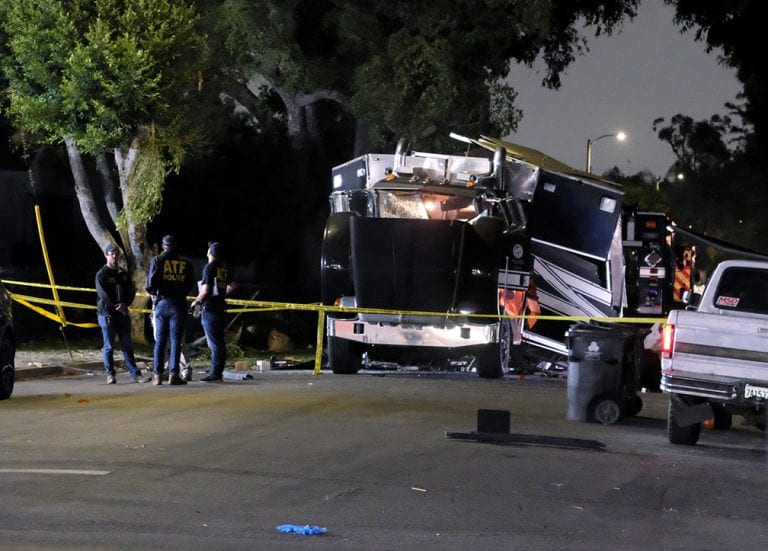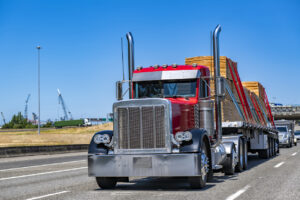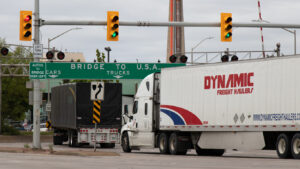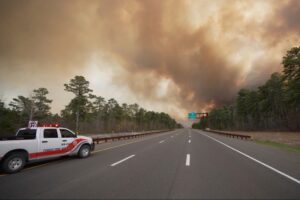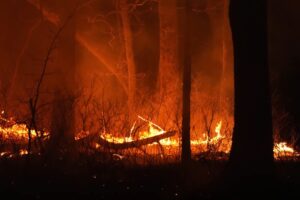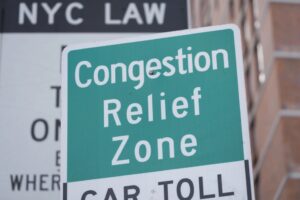LOS ANGELES — A massive explosion rocked a Los Angeles neighborhood June 30 as homemade fireworks were being destroyed by a bomb squad, leaving a trail of destruction, injuries and questions in its wake as the July Fourth holiday approaches.
Seventeen people were hurt — including nine Los Angeles police officers and a federal agent — in the blast, which also flipped and damaged cars and smashed windows in homes and a laundromat. The explosion was heard blocks away.
It could take days to determine why the material exploded inside a spherical containment vessel on a tractor-trailer, tearing the rig apart in what was supposed to be a safe operation to handle explosives that were too unstable to remove from a South Los Angeles neighborhood where tons of illegal fireworks were discovered.
The one-ton lid of the vessel flew into a backyard two blocks away, breaking a lemon tree and damaging the house, KNBC-TV reported.
Experts say the explosion was highly unusual, especially for a law enforcement agency with the size and resources of the Los Angeles Police Department. The blast could have been the result of human error — such as not correctly sealing the vessel or over-loading it with material — or a defect in the equipment like a micro-fissure that has grown with time and use. Or both.
“They were very lucky that nobody got killed here,” said Glenn Corbett, a fire science professor at John Jay College of Criminal Justice in New York.
Bomb squads nationwide will likely now double-check their own equipment in remote locations, to be sure there aren’t potential defects in their containment vessels, which cost tens of thousands of dollars, that could hurt more people, Corbett said.
The LAPD did not answer questions July 1 seeking information such as how old the containment vessel was and how many times it had been used and inspected. But Chief Michel Moore previously said “clearly, protocols were followed and pursued.”
“But something happened in that containment vessel that should not have happened, and we don’t know why,” Moore said. “But we intend to find out why.”
Less than 10 pounds (4.54 kilograms) of material was placed in the chamber, far less than its safety rating, Moore said. He described the material as 40 home-made devices the size of Coca-Cola cans with simple fuses and 200 smaller but similar devices.
“This vessel should have been able to dispose of that material,” he said. But instead there was a “total, catastrophic failure of that containment vehicle.”
Typically, the heavy-duty hydraulic doors will latch and lock — usually by remote — and the detonation is instantaneous. The displaced blast wave is absorbed by the vessel and released outside safely.
“You wouldn’t even know,” said Sean Dennis, president and co-founder of the United States Bomb Technician Association, besides a muffled ding and a light hiss when some of the pressure is released.
The LAPD has not said what company made the containment device. Attempts to reach several manufacturers July 1 were unsuccessful.
The explosion came after police had spent the day disposing of about 3,000 to 5,000 pounds (1,360 to 2,268 kilograms) of commercial-grade fireworks that were found in the home following an early-morning tip. Police found some of them on a patio in cartons stacked 8 to 10 feet (2.44 to 3 meters) high, Moore said.
Fireworks are illegal to sell or possess in Los Angeles and in unincorporated areas of the county.
A resident, Arturo Cejas, 27, was arrested on suspicion of possessing a destructive device, but he also may face charges of child endangerment because his 10-year-old brother was in the home, Moore said.
It wasn’t immediately known whether Cejas had an attorney who could speak on his behalf.
The fireworks cartons were marked “Made in China.” The police chief said they were bought out of state in order to sell them in the neighborhood for use on the Fourth of July.
Peter Diaczuk, a forensic science professor at John Jay, said the size of the blast indicated high-explosive devices that wouldn’t be used for a local Independence Day celebration.
As the holiday approaches, fire departments statewide are confiscating tens of thousands of pounds of illegal fireworks and warning users that setting them off could lead to devastating wildfires. Los Angeles police on July 1 announced that they seized another ton of illegal fireworks from a shipping container, and the bomb squad trucked it to a storage facility.
In LA, Moore said June 30 that three box trucks and a 53-foot (16-meter) trailer were brought in to load up the fireworks at the South Los Angeles home and move them to a safe location. However, the “improvised explosives” that were also found were too dangerous to move, the chief said.
There was a 300-foot boundary around the vessel — a typical safety range — and police had knocked on doors before the blast to evacuate homes on both sides of the street where the truck was parked. But firefighters later found people in some of the homes, officials said.
It’s not unusual for bomb squads to not know exactly what comprises the homemade explosives they are detonating, Diaczuk said.
“You don’t know what you’re dealing with. You don’t know what this character made,” he said. “It doesn’t come with ingredients in it like when you go to the grocery store.”
By Stefanie Dazio and Robert Jablon, The Associated Press
The Associated Press is an independent global news organization dedicated to factual reporting. Founded in 1846, AP today remains the most trusted source of fast, accurate, unbiased news in all formats and the essential provider of the technology and services vital to the news business. The Trucker Media Group is subscriber of The Associated Press has been granted the license to use this content on TheTrucker.com and The Trucker newspaper in accordance with its Content License Agreement with The Associated Press.

